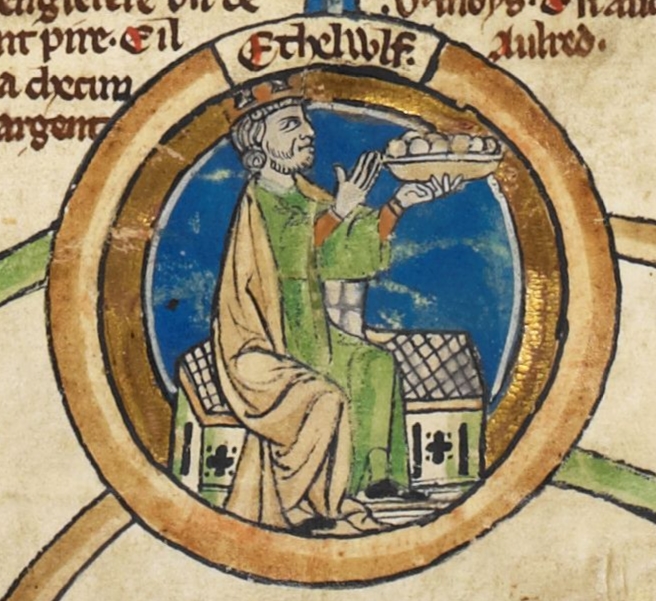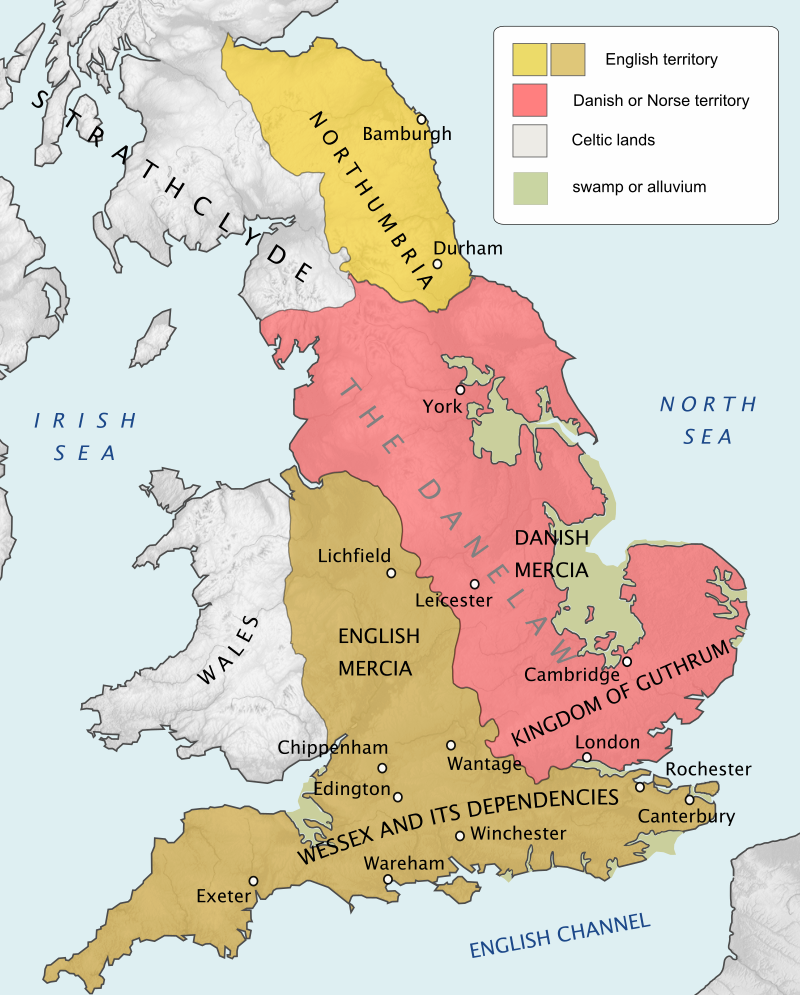by Susan Flantzer © Unofficial Royalty 2019

Statue of Alfred the Great in Wantage, Oxfordshire; Credit – By Steve Daniels, https://commons.wikimedia.org/w/index.php?curid=8862807
Alfred the Great was King of Wessex and later styled himself King of the Anglo-Saxons. Alfred and Cnut, King of England, Denmark, Norway, and parts of Sweden are the only British monarchs to be given the epithet “the Great”. Born circa 847 – 849, probably at a royal palace in Wantage, now in Oxfordshire, England, he was the youngest of the four known sons and the youngest of the five known children of Æthelwulf, King of Wessex and his first wife Osburga.
Alfred had four known elder brothers and one known elder sister:
- Æthelstan, King of Kent (died circa 851–855), was King of Kent under the authority of his father from 839 until predeceasing his father
- Æthelswith, Queen of Mercia (died 888), married Burgred, King of Mercia, no children
Æthelbald, King of Wessex (died 860), married Judith of Flanders, his father’s second wife and widow, no children - Æthelberht, King of Wessex (died 865)
- Æthelred I, King of Wessex (circa 847 – 871), married Wulfthryth, two known sons Æthelhelm and Æthelwold

Alfred’s father King Æthelwulf of Wessex; Credit – Wikipedia
From 854 – 855, Alfred accompanied his father on a pilgrimage to Rome and then they spent some time at the court of Charles the Bald, King of West Francia. Being the fourth of four sons, Alfred was not expected to succeed to the throne and was probably being prepared for a career in the Roman Catholic Church. In 856, Alfred’s father King Æthelwulf married Judith of Flanders, daughter of Charles the Bald. Alfred’s mother Osburga had probably died, although it is possible that she had been put aside. King Æthelwulf and Judith had no children and after King Æthelwulf’s death, she married his son and successor Æthelbald.
King Æthelwulf died on January 13, 858, and was succeeded by his eldest surviving son Æthelbald in Wessex and his next surviving son Æthelberht in Kent. When King Æthelbald died two years later, Æthelbert became King of Wessex and remained King of Kent. Alfred’s public life began in 865 with the accession of his fourth brother Æthelred I. Also in 865, the Great Heathen Army of Danes landed in East Anglia with the goal of conquering the Anglo-Saxon kingdoms. During King Æthelred I’s reign, Alfred fought beside him against the Great Heathen Army led by Ivar the Boneless and his brother Halfdan Ragnarsson. King Æthelred I was wounded at the Battle of Marton and died shortly afterward on April 23, 871. Because King Æthelred I left two young sons, Æthelhelm and Æthelwold, who were deemed too young to succeed to the throne, Alfred became King of Wessex.

Alfred’s wife Ealhswith; Credit – Wikipedia
In 868, Alfred married Ealhswith, daughter of a Mercian nobleman, Æthelred Mucel, Ealdorman of the Gaini and his wife Eadburh, a member of the Mercian royal family. As was customary in ninth-century Wessex, Ealhswith was not given the title of queen.
Alfred and Ealhswith had five known children:
- Æthelflæd, Lady of the Mercians (died 918), married Æthelred, Lord of the Mercians, had one daughter
- Edward the Elder, King of the Anglo-Saxons (circa 874 – 924), married (1) Ecgwynn, had two children including Æthelstan, King of England (2) Ælfflæd, had eight children (3) Eadgifu, had four children including Edmund I, King of England and Eadred, King of England
- Æthelgifu, Abbess of Shaftesbury
- Æthelweard (died circa 922), married and had two children
- Ælfthryth, Countess of Flanders (died 929), married Baldwin II, Count of Flanders, had four children
Battles with the Danish invaders continued into the early years of Alfred’s reign. Alfred concluded a peace treaty in 876 which involved an exchange of hostages and oaths. However, the Danes broke their oath and killed all the hostages. In January 878, the Danes made a sudden attack on Chippenham, a royal stronghold where Alfred had spent Christmas. Many people were killed but Alfred and a small group made their way to the marshes of Somerset. A fort was built at Athelney in the marshes where Alfred organized an effective resistance movement.
In May 878, Alfred left Athelney and led his army to Wiltshire where large contingents from Somerset, Wiltshire, and Hampshire also gathered. At the Battle of Edington, the Anglo-Saxon army defeated the Great Heathen Army led by Guthrum. Under the Treaty of Wedmore, the Danes agreed to withdraw from Wessex and settle in East Anglia, Mercia, and Northumberland in land ceded to them called the Danelaw. The Viking leader Guthrum became a Christian and Alfred was his godfather at his baptism, giving him the name Athelstan.

England in 878; Credit – By Hel-hama – Own work, CC BY-SA 3.0,
The next eight years were a peaceful period in Wessex. Alfred came to be regarded by the Anglo-Saxons as their overlord and although he was never really king of all England as the Danes held the north and east, he styled himself King of the Anglo-Saxons.

Map of the burghs; Credit – By Hel-hama – Own work, CC BY-SA 3.0
Some accomplishments during the reign of Alfred the Great:
- Burhs: Alfred the Great set about building a system of fortified towns or forts, known as burhs or burgs, in response to the continued Viking threat. These burhs included former Roman towns where stone walls were repaired and perimeter ditches added along with temporary forts, and new towns.
- Navy: Alfred ordered the construction of a small fleet of longboats that had 60 oars and were twice the size of Viking longboats. His goal was to intercept raiding Viking fleets before they landed
- Legal reform: Alfred issued the Doom Book in which he compiled a legal code based on three prior Anglo-Saxon legal codes which he found the most just, those of Æthelberht of Kent (circa 602), Ine of Wessex (circa 694), and Offa of Mercia (circa 786). Alfred also included the Ten Commandments and rules of life from the Mosaic Code and Christian ethics. Alfred’s legal code was administered by local shire reeves (or sheriffs) and judges.
- Education: The Danish raids had a devastating effect on learning in England. Inspired by the educational reforms of Charlemagne almost a century before, Alfred undertook an ambitious effort to revive learning. Scholars were recruited from all over Britain and abroad. Alfred established a court school for the education of his own children, children of the nobility, and children of lesser birth. He declared that all sons of freemen should attend school and learn to read and write in English.
Except for a brief period in 885, peace was maintained until 893 when a war with the Danes in East Anglia started and lasted until 897. The Danes caused problems in Mercia and Wales but were unable to penetrate Wessex’s defenses.

Alfred the Great’s statue in Winchester; Credit – Wikipedia
Alfred had long suffered from a mysterious illness with periodic painful attacks. Alfred’s contemporary biographer, the Welsh monk Asser, gave a detailed description of his symptoms and modern doctors suspect that he had either Crohn’s disease or hemorrhoidal disease. However, Alfred’s grandson King Eadred also suffered from ill health all his life. He had symptoms similar to the symptoms Alfred had. A genetic disease such as porphyria, which King George III may have had, is also a possibility. Alfred died on October 26, 899 at around the age of 50 from unknown causes. He was buried in the Old Minster in Winchester but that is not the end of the story for Alfred’s remains.
Four years later, Alfred’s remains were moved to the New Minster, a royal Benedictine abbey founded in 901 in Winchester. Alfred had intended to build the abbey but only got around to buying the land before he died. His son and successor, King Edward the Elder, finished the abbey according to Alfred’s wishes. In 1109, King Henry I ordered the New Minster to be moved to Hyde Mead and so Hyde Abbey was built just outside the walls of Winchester. When the new church of Hyde Abbey was consecrated in 1110, the remains of Alfred, his wife Ealhswith, and his son Edward the Elder were carried in state through Winchester and interred before the Hyde Abbey high altar.
In 1539, during the reign of King Henry VIII, Hyde Abbey was dissolved and demolished during the Dissolution of the Monasteries. Over the next 250 years, the choir end of Hyde Abbey, where Alfred, his wife, and his son had been interred, was gradually forgotten. In 1788, the land where Hyde Abbey had been located was to become the site of a small local prison. The prisoners were put to work digging the foundation and they came across a number of graves.
In the 19th century, excavations carried out on the site of Hyde Abbey claimed to have found the remains of Alfred the Great which then were reburied in a simple grave outside nearby St. Bartholomew’s Church. More recent excavations of the sites have not given positive or definite results. Bones found in 1999 proved to be those of an elderly woman. The bones found in 2003 were carbon-dated but the results showed that they were from the 1300s and therefore could not be Alfred’s. A fragment of a pelvis from the 1999 excavation was found in a box in a Winchester museum storeroom. Carbon dating showed that the pelvis fragment comes from the correct period. It has been suggested that this bone may belong to either Alfred or his son Edward but this remains unproven.
This article is the intellectual property of Unofficial Royalty and is NOT TO BE COPIED, EDITED, OR POSTED IN ANY FORM ON ANOTHER WEBSITE under any circumstances. It is permissible to use a link that directs to Unofficial Royalty.
England: House of Wessex Resources at Unofficial Royalty
- Unofficial Royalty: House of Wessex Index
- Unofficial Royalty: British Royal Burial Sites: House of Wessex
- Unofficial Royalty: Coronations before the Norman Conquest (871 – 1066)
Works Cited
- Ashley, M. (1998). The Mammoth Book of British Kings & Queens. New York: Carroll & Graf Pub.
- Cannon, J. and Griffiths, R. (1988). The Oxford Illustrated History of the British Monarchy. Oxford: Oxford University Press.
- Dodson, A. (2004). The Royal Tombs of Great Britain. London: Duckworth.
- En.wikipedia.org. (2019). Alfred the Great. [online] Available at: https://en.wikipedia.org/wiki/Alfred_the_Great [Accessed 9 Feb. 2019].
- Williamson, D. (1998). Brewer’s British Royalty. London: Cassell.
